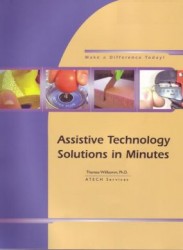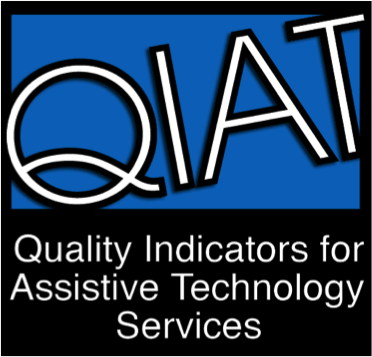
Assistive Technology Resources
Assistive technology resources for students who are blind or visually impaired
By Tara Mason
Teachers and others frequently ask what some Assistive Technology resources are that can help me as in choosing assessments. Here are some suggestions:
-
Quality Indicators for Assistive Technology (QIAT; Zabala, 2012)
The QIAT community is a national group promoting advocacy, assistive technology and learning with assistive technology. The group has provided free resources for teachers to use when advocating for AT or when implementing AT with their students. There are indicators that can be used by: teachers, consumers, administrators, universities, professional developers, and policy makers. The QIAT provides a set of AT specific standards to use when implementing AT with students and can help teams include the best practices when facilitating AT use.

Student Environment Tools & Tasks (SETT; Zabala, 2005, 2007)
Zabala developed the SETT framework in 2005 which outlines AT considerations and implementation in a simple format of: student, environment, tasks and tools. The SETTFramework is free to use for any educator and many teams have modified the SETT to include specific questions unique to their student. It is a framework to help think through AT implementation but does not include a comprehensive AT assessment that may be needed when developing an AT plan for the first time for a student. Zabala’s SETT framework includes forms that walk teachers through considering the AT needs using the SETT prompts, data gathering for trialing AT to find the best fit, tool selection and implementation facilitation with planning guides for effective strategies when using AT.
What are some AT evaluations and assessments?
1. AT For Students Who Are Blind or Visually Impaired: A Guide to Assessment (Presley & D’Andrea, 2005)
This textbook is 500 pages and includes comprehensive information regarding assistive technology and discussion about the utility of low and high tech devices. The discussion focuses on the utility of an item and how it may be used more than specific product descriptions. Part 2 of the text includes a step-by-step process for conducting an assistive technology assessment specific to a student with a visual impairment. The book includes a set of reproducible blank forms that can be used for AT assessment. The book can be purchased in an electronic format and the forms could be used as PDF digital files as well instead of completing assessments by with pen and paper.
2. Evaluating Visually Impaired Students (EVALS; Sewell, 1997, 2007)
The EVALS evaluations are a comprehensive set of reproducible checklists with integrated progress monitoring for every conceivable area of learning for a student with visual impairments 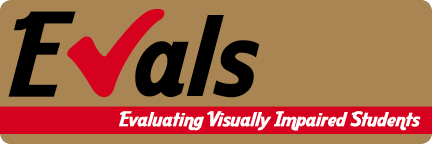 and can produced scored evaluations for IEPs. It is a five part set that includes two books of evaluations for ECC areas, on book composed of evaluations of subject areas, practical academics and basic skills, independent living skills assessments, and TAPS comprehensive assessment (regarding orientation and mobility to be used in conjunction with the TAPS curriculum guide). The set is priced at $125 for a print and digital copy of the entire kit. The independent living skills assessment areas include specific AT evaluations and on overview assessment to help teams identify appropriate AT. For example, there is an evaluation entitled, “Technology Skills,” providing an overview evaluation tool and several other evaluations provide a tool for identifying specific need areas such as, keyboarding, scanners, speech technology, functional use of assistive tools, computer use, braille devices, tactile graphics for math, etc.
and can produced scored evaluations for IEPs. It is a five part set that includes two books of evaluations for ECC areas, on book composed of evaluations of subject areas, practical academics and basic skills, independent living skills assessments, and TAPS comprehensive assessment (regarding orientation and mobility to be used in conjunction with the TAPS curriculum guide). The set is priced at $125 for a print and digital copy of the entire kit. The independent living skills assessment areas include specific AT evaluations and on overview assessment to help teams identify appropriate AT. For example, there is an evaluation entitled, “Technology Skills,” providing an overview evaluation tool and several other evaluations provide a tool for identifying specific need areas such as, keyboarding, scanners, speech technology, functional use of assistive tools, computer use, braille devices, tactile graphics for math, etc.
3. University of Kentucky Assistive Technology Toolkit (UKAT; 2002)
UKAT is a comprehensive toolkit developed from a six-year research partnership between Kentucky public schools and the University of Kentucky. It is provided as a free resource for teachers implementing AT. It includes pre-assessment considerations such as present levels for technology knowledge and skills, checklists and implementation guides, trialing and data collection tools, and evaluation of AT effectiveness data collection. This assessment includes enough information to provide a comprehensive assessment of AT consideration, trialing and implementation. It is not a formal evaluation under the strict definition but could provide enough data-driven support if acceptable for your district.
4. Wisconsin Assistive Technology Initiative (WATI)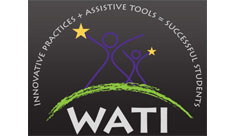
The WATI is another comprehensive AT assessment that can be used to determine, implement and monitor progress of AT for any student. It beings with AT consideration guide and includes assessment forms with data collection throughout the process. It is not a formal evaluation under the strict definition but could provide enough data-driven support if acceptable for your district.
Additional resources for AT solutions:
TechPotential
Texas School for the Blind and Visually Impaired (TSBVI)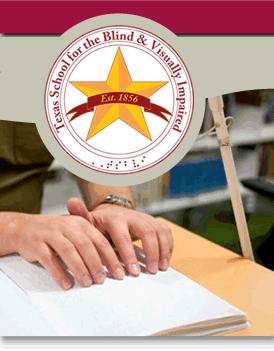
TSBVI Outreach Assistive Technology


